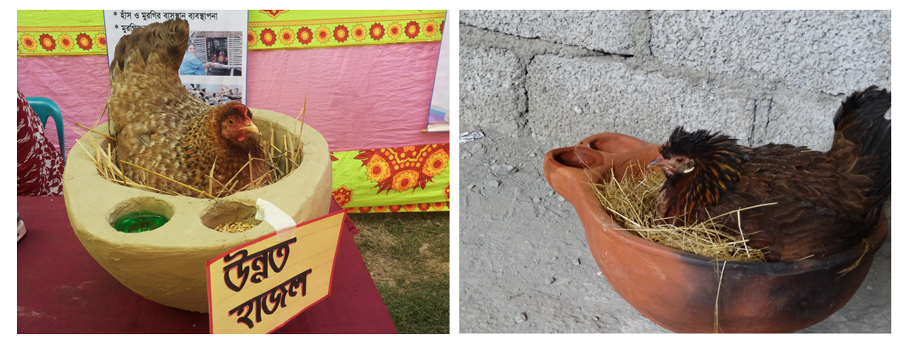Broody: the Essential Art of Hatching
by Frank van Steenbergen, Abraham Abhishek, and Reinier Veldman
January 13, 2020

‘Hazol’ hatching pans developed in Bangladesh (left), adapted to Ethiopian conditions (right)
The difference a village chicken can make to the life of a poor woman is amazing. A safe source of income, independent capital asset, universal delicacy, main source of protein, eggs ranks high in the list of essential brainfood. They are a major ingredient in diets that stimulate the development of mental capacity in villages all over the world.
In many countries, village poultry make up the major share of national poultry population. For instance, In Ethiopia it is more than 95%. Whereas 20 years ago less than 30% of animal protein produced in the world come from poultry, nowadays this is closer to 40%. In developing countries the consumption of poultry has more than doubled in the last two decades.
Among poultry, chicken are becoming more and more important. However, there is much scope for improvement in how chicken are kept. Currently, scavenging is the norm, which leads to underweight and diseased chicken. There are simple ways to turn this around – and make a big difference in the production of meat and eggs, and to rural health in general. The key element is better hatching. This is where we bring the hatching pan into the picture.
The hatching pan is a significant innovation, and at the same time a basic tool. What it does is simple – it combines a comfortable place for the chicken to hatch its eggs with two small containers– one for water and one for food. Thus, the hen always has food and water at hand. This keeps it from foraging around to satisfy its hunger and quench its thirst, and neglect its eggs in the process. The hatching pan has been seen to double the number of eggs that are successfully hatched. It also allows the hen to grow in size. A larger hen can lay and incubate more eggs. She can hatch eggs weighing half her body weight. For instance, if a hen weighs 1.5 kg, it can incubate 750 gm of eggs (around 20 eggs). Therefore large-sized hens, rather than the usual scrawny village versions, are good news.
There is more to the art of hatching than the hatching pan. Proving a bedding of ash, straw, and napthalene insulates the eggs better. Besides, warming the eggs slightly (up to 24 degrees centigrade), and placing them in the afternoon, ensures that they do not get a cold shock at night.
Here are a few more chicken essentials:
- To increase productivity, chicks should be separated from the hen a week after they hatch. This will induce her to produce more eggs and go broody again.
- If one wants to separate eggs that are fertilized from those that are not, one can ‘candle’ the eggs after five days— this means shining torch light through the translucent shells. If veins appear to develop, it means that the egg is fertilized and can be left to hatch. One can also look at the shape of the eggs – a pointed egg usually contains a rooster, an oval shape a hen. Thus, one can sort eggs strategically and increase the number of hens.
- Ensure balanced feed: A chicken eats typically 50-60 gram of food a day. It is best to have grains, some protein, some calcium (old crushed egg shells) and a pinch of salt in the mix.
- Provide a sand bath for the chicken – so they can clean themselves with the sand
- A small, double-storied, well-ventilated pen on stilts will do wonders for the health and well-being of the chicken. It protects them from predators and from cold, dampness, and diseases. The chicks can be kept separate from the hens at the at the top floor.
- Finally, providing vaccination is important. It protects the chicken and its extended family from diseases such as the Newcastle disease.
The video below showcases how hatching pans have enabled women in coastal Bangladesh to take up poultry rearing as a profitable livelihoods option.
The following video shows how hatching pans can be made very easily, even by those not skilled at pottery.
These videos were produced under the aegis of the Blue Gold project in Bangladesh. For more information, please visit www.bluegoldbd.org
The hatching pans are being promoted in Ethiopia and Pakistan by MetaMeta www.metameta.nl and the Flood Based Livelihoods Network www.spate-irrigation.org




